Recently, our Sr. Product Manager, Clay Wolcott, co-hosted a webinar with Adam Richter, Sr. Optimization Solutions Architect at AWS. Their session focused on rate optimization strategies. Specifically, an advanced method for leveraging AWS Savings Plans to reduce costs, improve commitment flexibility, and mitigate lock-in risk.
Clay and Adam discussed measuring rate optimization outcomes, choosing the right mix of discount instruments, and how automation can make commitment management more scalable and lead to consistently better outcomes.
Building on that conversation, this blog provides a detailed look at how FinOps teams can improve their cloud cost efficiency by leveraging rate optimization as a core practice.
If you’d prefer to watch the full discussion, you can catch the webinar recording here.
The Two Pillars of Cloud Cost Optimization: Rate and Usage Optimization

Cloud cost optimization rests on two foundational levers – rate and usage. Usage optimization focuses on reducing how much cloud you consume. This includes rightsizing, shutting down idle resources, using auto-scaling, and moving non-critical workloads to lower-cost services or regions. These are operational decisions that help teams run lean infrastructures.
Rate optimization, on the other hand, is about lowering the price you pay for that usage. It involves using commitment-based pricing models such as Reserved Instances and Savings Plans to access discounted rates in exchange for a time-bound commitment. Rate optimization requires little to no engineering involvement and is often the fastest way to improve cost outcomes.
While both are essential, they are often treated as separate or sequential. Teams may delay rate optimization, thinking they first need to finalize usage efficiency. But usage patterns are dynamic. Waiting for a perfect baseline means postponing savings indefinitely. On the flip side, committing without addressing major inefficiencies can lead to wasted spend.
The most effective approach is to manage both together. Rate and usage optimization are not competing strategies, they are complementary efforts that should run in parallel. This mindset enables continuous improvement and ensures that savings opportunities are captured in real time, not missed waiting for ideal conditions.
Measuring Rate Optimization Outcomes
What cannot be measured cannot be improved. In cloud cost optimization, knowing how well your commitment strategy is performing requires more than just tracking traditional metrics like coverage or utilization. These metrics are helpful, but they don’t tell the full story. To close that gap, ProsperOps introduced two purpose-built metrics: Effective Savings Rate (ESR) and Commitment Lock-In Risk (CLR).
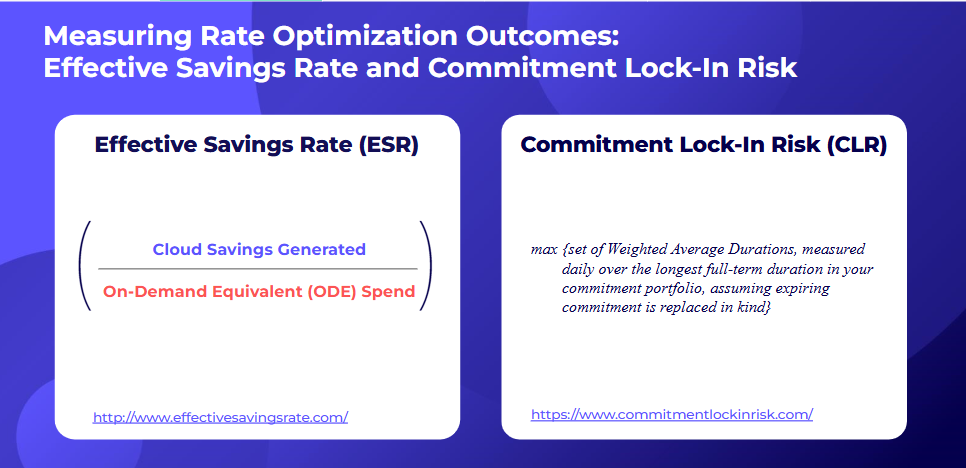
Effective Savings Rate (ESR) measures the total savings generated through commitment-based pricing as a percentage of your total on-demand equivalent usage. It answers a simple question: how much are you saving relative to what you would have paid at on-demand rates? For example, if your environment would cost $250 per hour at on-demand pricing but you’re only paying $205 through commitments, your ESR is 18 percent.
Commitment Lock-In Risk (CLR) quantifies the time dimension risk of committing to a cloud provider in exchange for a discounted rate. It is measured in months and calculated as the weighted average duration of your active commitments. A higher CLR means more long-term exposure. A lower CLR indicates shorter commitment windows and more flexibility to adjust if usage changes.
Together, ESR and CLR offer a balanced view of cost performance and risk. They allow teams to track both how much they are saving and how tightly those savings are tied to future commitment decisions.
Six AWS Best Practices for Commitment Management
As commitment strategies evolve, so do the challenges around maintaining flexibility, maximizing savings, and minimizing risk. Adam Richter, Solutions Architect at AWS shares six best practices to help teams build a more resilient and cost-effective commitment approach:
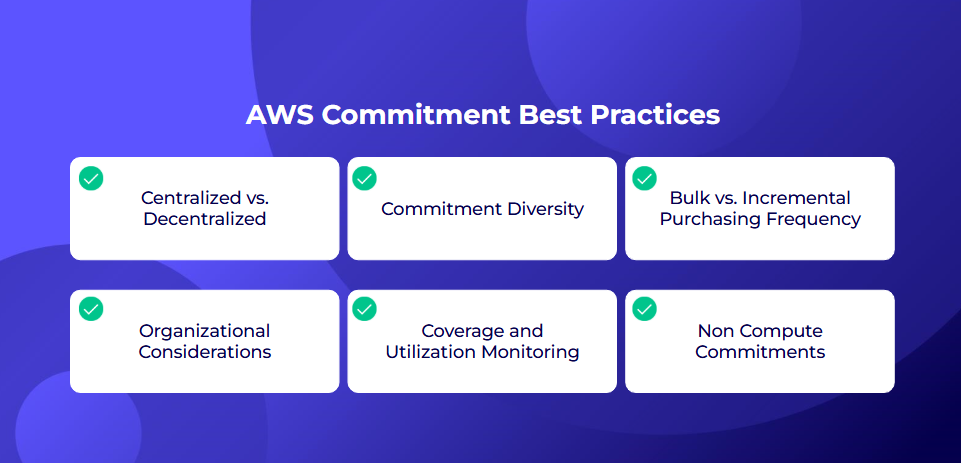
Centralized vs Decentralized Commitment Ownership
Decide where commitment purchasing authority should reside: a central payer account managed by a FinOps or centralized team, or distributed across individual business units or linked accounts. Centralizing commitments improves visibility and control, ensures broad coverage, and reduces the risk of fragmented discount applications. In contrast, decentralizing can give teams autonomy and flexibility for account-specific workloads. Many organizations adopt a hybrid model – centralizing widely used commitments while allowing decentralized purchasing for unique or isolated workloads.
Diversify Your Commitment Portfolio
Relying on a single type of commitment limits both savings and flexibility. For instance, an organization might standardize on Compute Savings Plans for broad applicability, but they miss out on the deeper discounts available through EC2 Instance Savings Plans for stable backend services or Standard RIs for region-specific production workloads. A more deliberate mix, matched to workload characteristics, allows for greater savings without compromising adaptability.
Purchase Commitments Incrementally, Not in Bulk
Rather than making large, infrequent purchases, adopt a “rolling” strategy. Smaller, recurring purchases allow you to adapt more easily to usage changes, reduce long-term lock-in, and maintain more consistent coverage. This incremental approach also lowers the pressure to predict future usage perfectly and improves agility when workloads shift unexpectedly.
Align Commitments With Organizational Context
Cost optimization should not happen in isolation. Strategic commitment planning requires input from engineering, product, and finance to stay aligned with upcoming initiatives such as migrations to Graviton, modernizations, or expected scale-downs. Understanding what is in flight, what is sunsetting, and what is scaling helps avoid overcommitment and ensures discount strategies reflect real workload trajectories.
Monitor Coverage and Utilization Continuously
Track how much of your usage is covered by commitments and how well those commitments are utilized. Coverage tells you how much of your spend is discounted. Utilization shows how effectively you’re using what you’ve committed to. Gaps in either signal missed savings or overcommitment.
Low coverage often means missed savings, while poor utilization suggests overcommitment and wasted spend. Without active monitoring, it’s easy for these inefficiencies to go unnoticed, especially as usage patterns shift over time. Regularly reviewing both metrics ensures your rate optimization strategy stays aligned with how your environment actually operates.
Use Commitment Metrics Beyond Compute
Commitment management is often focused on EC2, which is reasonable since compute is the highest area of spend for most AWS customers. However, services like RDS, OpenSearch, ElastiCache, MemoryDB and Redshift also offer Reserved Instances with meaningful savings potential. These non-compute commitments are frequently overlooked due to added complexity, but they represent a significant opportunity for cost reduction when managed effectively. Including them in your broader strategy ensures more complete rate optimization coverage.
Optimizing Commitments for Cyclical Workloads
Cyclical workloads are common in cloud environments that take full advantage of elasticity. These are workloads where usage patterns fluctuate in predictable ways such as by hour, by day, or across different times of the month. Despite their consistency, they are often managed with overly conservative commitment strategies.
A typical approach is to commit only up to the trough or the lowest observed usage. This ensures that commitments are fully utilized, which may seem efficient. But while utilization stays high, overall savings remain limited. In the example on the left, this approach results in 100 percent utilization, but only 49 percent coverage and an Effective Savings Rate of 24.6 percent.
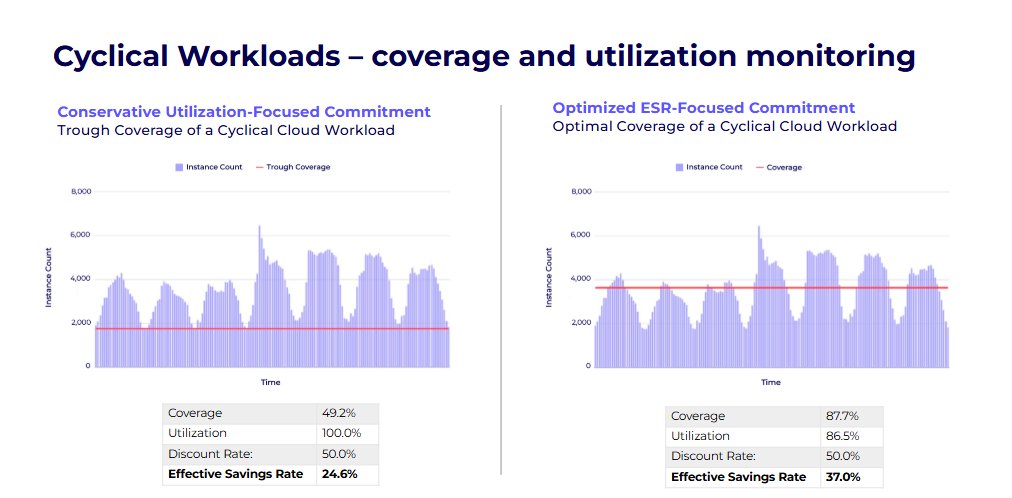
Now compare that to the optimized strategy on the right. Instead of stopping at the trough, it commits slightly above it, into the cyclical range where usage consistently fluctuates. Utilization drops slightly to 86.5 percent, but coverage rises to nearly 88 percent and the ESR significantly improves from 24.6 to 37 percent.
Many teams focus solely on utilization as a success metric, but that view can leave savings on the table. Optimizing for Effective Savings Rate shifts the goal from perfect commitment usage to higher overall cost performance. This concept of optimizing for ESR instead of chasing perfect utilization, is often misunderstood. It’s not about overcommitting blindly, but about identifying the point in the workload cycle where additional coverage still yields better outcomes. Even partial commitment to the cyclical range improves savings without creating excessive lock-in.
This strategy assumes a mature environment with predictable workload patterns and some level of auto-scaling or scheduling already in place. If your usage graph looks like a flat line, this likely isn’t the right starting point. But if you’re already scaling regularly, you may be underutilizing commitment potential without realizing it.
To explore the math and trade-offs in more detail, read our full breakdown: How to Maximize Cloud Savings on Cyclical Workloads Using Commitment-Based Discounts?
Bulk vs Incremental Commitment Strategies
How and when you purchase AWS commitments can significantly impact both cost savings and operational risk. Two common approaches are bulk purchasing and incremental purchasing, which ProsperOps refers to as Adaptive laddering. These represent very different strategies in how organizations manage rate optimization over time.
The Pitfalls of Bulk Purchasing
A bulk purchase strategy involves making a single, large commitment based on current usage or future projections. This is usually done once a year or during a major planning cycle. On the surface, it seems efficient. But this “all in” approach creates a rigid commitment structure that’s difficult to adjust as conditions change.
The challenge with this model is forecasting. Usage patterns can shift quickly due to architectural changes, scaling efforts, or business re-prioritizations. If usage drops after a bulk purchase, the commitment plan goes underutilized, leading to cloud waste. If usage increases, new spend goes uncovered and is billed at on-demand rates.
According to our observations, with a 29 percent discount, the break-even point for a Compute Savings Plan occurs at about eight and a half months. That means your usage must remain consistent for most of the year just to recover the value of the discount.
There are two typical outcomes when using bulk purchasing:
- Conservative Coverage: You commit at or just below current usage levels. This avoids waste but leaves significant savings on the table as future usage grows.
- Aggressive Coverage: You commit above current usage, hoping future growth will fill the gap. If usage dips instead, the result is wasted spend and higher Commitment Lock-In Risk.
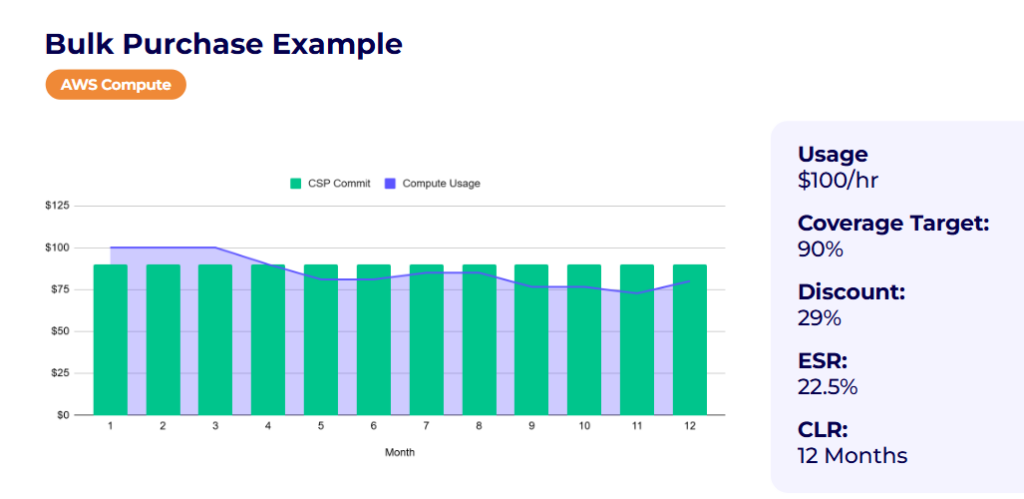
The example above shows how a single large commitment leads to a Commitment Lock-In Risk (CLR) of 12 months and an Effective Savings Rate (ESR) of just 22.5 percent. Any deviation in usage creates exposure that cannot be corrected until the commitment expires.
The Value of Incremental Purchasing
Incremental purchasing is a strategy of spreading commitments out over time. Instead of making one large purchase, you make smaller, periodic ones timed quarterly, monthly, or even weekly. This gives you multiple entry points to adjust your coverage based on recent usage trends.
Each new commitment has a shorter forecast window, typically three months instead of a year, which makes it easier to align with real-world usage. Expiring commitments can be adjusted or allowed to lapse, reducing exposure and improving flexibility.
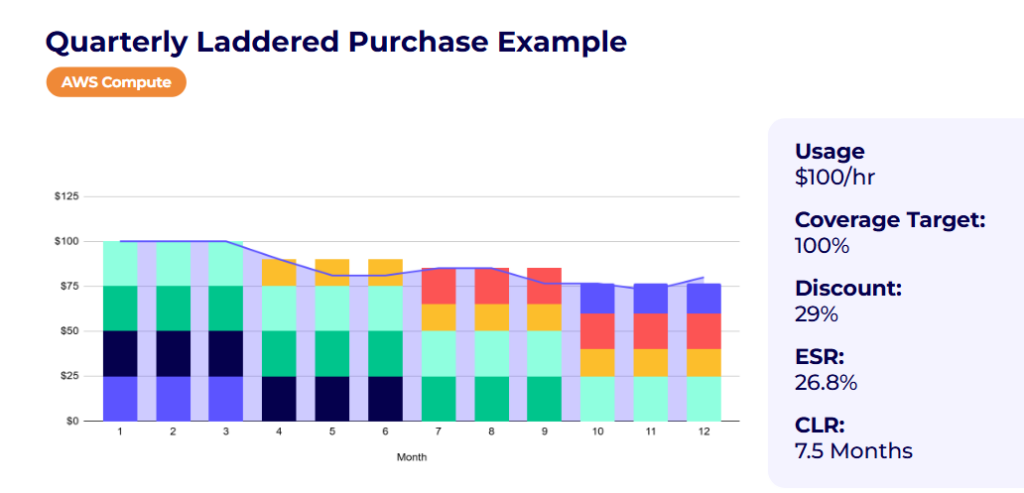
In the example shown, quarterly commitments are layered on top of one another. Each renewal is an opportunity to reassess current usage and adjust coverage accordingly. The result is a higher ESR of 26.8 percent and a significantly lower CLR of 7.5 months. For an environment with one million dollars in annual usage, this uplift translates to over $500,000 in additional savings.
With incremental purchasing:
- You reduce long-term forecasting pressure.
- You maintain flexibility to respond to workload shifts.
- You improve coverage consistency without overcommitting.
- You create built-in opportunities to adapt every quarter.
This approach requires more frequent evaluations, but each evaluation is smaller and easier to manage. And while it takes time to fully ramp coverage, the long-term savings and agility it provides far outweigh the slower start.
Why Automation is Essential for Effective Commitment Management
Moving from bulk to quarterly laddered purchases is a major step forward, but even quarterly cadences require manual effort, coordination, and forecasting. As organizations mature, many aim to increase purchase frequency to monthly, weekly, or even daily, to better align with usage trends.
Without automation, this level of precision is difficult to sustain.
Automated commitment management removes guesswork and operational overhead. It enables you to:
- React faster to usage changes by layering smaller, short-term commitments more frequently.
- Reduce commitment lock-in by letting expiring plans lapse when usage drops.
- Eliminate long-term forecasting and replace it with near-term, usage-driven purchasing decisions.
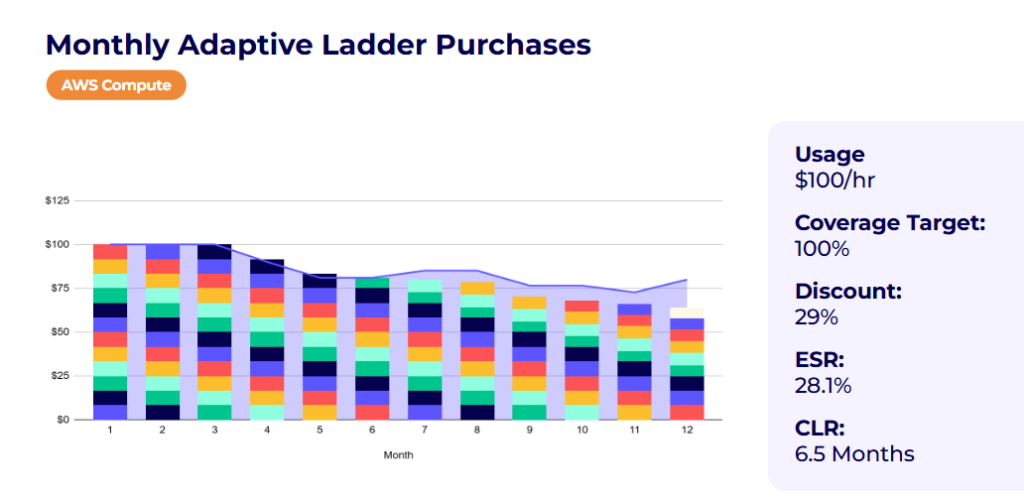
In the example shown, monthly adaptive laddering increases Effective Savings Rate (ESR) from 26.8 percent to 28.1 percent, which translates to $156,000 in additional annual savings for an environment with one million dollars in usage. At the same time, Commitment Lock-In Risk drops to just 6.5 months, providing greater flexibility and control.
ProsperOps delivers cloud savings-as-a-service, automatically blending discount instruments to maximize your savings while lowering Commitment Lock-In Risk. Using our Autonomous Discount Management platform, we optimize the hyperscaler’s native discount instruments to reduce your cloud spend and place you in the 98th percentile of FinOps teams.
- Weekly commitment purchases that adjust to real-time usage
- Full support for compute services like EC2, Fargate, and Lambda
- Coverage for complex non-compute RIs such as RDS, ElastiCache, OpenSearch, MemoryDB, and Redshift
- Portfolio diversification across Savings Plans and Reserved Instances
- Continuous laddering that adapts commitment amounts and timing with no manual intervention.
In addition to autonomous rate optimization, ProsperOps now supports usage optimization through its resource scheduling feature, ProsperOps Scheduler. Our customers of Autonomous Discount Management™ (ADM) can now automate resource state changes on weekly schedules to reduce waste and lower cloud spend.
Your teams stay focused on strategic FinOps goals, while ProsperOps automates rate and usage optimization behind the scenes.
Make the most of your cloud spend with ProsperOps. Schedule your free demo today!





